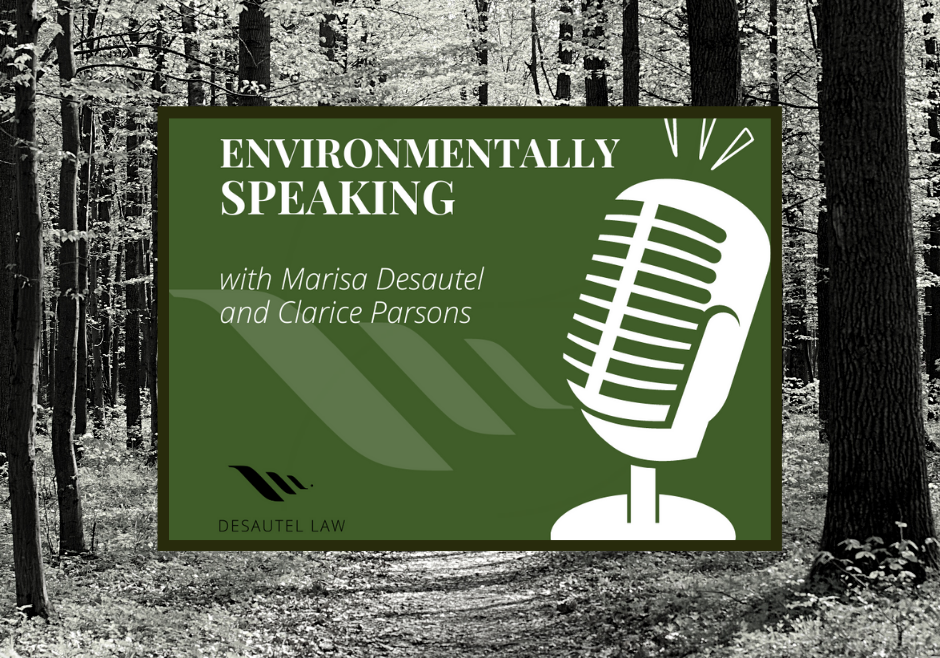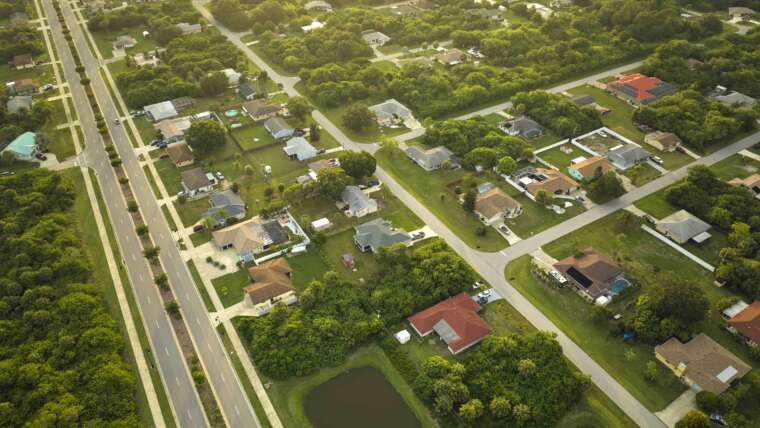In this episode, we discuss land use in residential and commercial developments, and why it’s so important for local government leaders to have a longterm plan in mind as smaller areas rapidly grow.
EP 21: Land Use
CLARICE: All righty. Good morning, everybody, or at least snowy morning on our end. We’re enjoying a nice New England snow day and it’s mostly nice because we get to work from home.
MARISA: It’s true. Good morning, everyone. This is Marisa Desautel. You’re listening to Environmentally Speaking. I’m an environmental attorney with a few decades of experience.
CLARICE: And I’m Clarice coming in with questions and topics we find interesting that you guys write in about. So what are we talking about today? You came up with an interesting and exciting topic.
MARISA: Yeah. Kind of relevant to my life, anyway. I just got back from a trip out to Montana. I was there for the holidays and had never been before and it was, like I was telling you earlier, everything that you think Montana would be, breathtaking, peaceful, quiet. And it led me to start thinking while I was out there and now that I’m back about land use which I know is not completely intuitive, but.
CLARICE: Yes. Every vacation I take I think, land use.
MARISA: Yeah. Well, I’m a little bit of a nerd in that respect because one of the reasons I wanted to go to Montana was for the landscape and the habitat and nature and seeing that part of the United States. So I guess it is a little bit more inherent in my personality to consider really negative things when I’m on vacation including how unfortunate it is that in this country our development and land use policies don’t seem to have a lot of forward thinking contained in them. You know, some do.
I’ve got a lot of involvement and experience at the municipal level representing zoning boards and planning boards. And for the most part I can say that those folks are concerned with the future land development, but historically and for other municipalities in other states maybe I don’t know that that’s necessarily the case. We’re always fighting this battle between progress and conservation where progress really just comes down to people making money and conservation is seen as an impediment to making money. So that’s what I mean by I’m in Montana thinking about land use.
[0:02:58] CLARICE: I mean, even on a smaller scale, like I’m sure Montana must have been just, for lack of a better word, really majestic to kind of look at all that sprawling space, but I think on a smaller scale we can relate with our own neighborhood development. I’m starting to sound like my parents in the sense that, you know, like, oh, they keep putting more and more houses, or they’ll put a house anywhere.
And you can see how that affects your neighborhood by the addition of – you know, even those small patches of undeveloped lots, that’s where your neighborhood animals live. If you don’t have trees in your yard or if you don’t have a super kind of plant populated yard, your neighborhood animals are living in those like tiny lots in those small wooded areas. So on a small scale to see more and more of those houses come up, you start looking around going, oh, the neighborhood foxes don’t have anywhere to live anymore, or, you know, deers are living on that median strip on the highway or those little on an off-ramp little circles, so.
MARISA: Yeah. Exactly. Or the animals just vacate because there’s too much competition for that small amount of land. And it’s not something that gets a lot of consideration at the government level and definitely not at the developer level because upland habitat like that is not regulated. There was a recent – when I say recent I mean maybe in the past ten years or so – a recent push to try to bring stakeholders together and collaborate on a policy for regulation of forested habitat in Rhode Island.
I don’t know what the current status of that is, but what I can tell you is that in my experience recently forested habitat is still not regulated at the local level to any great extent. There are some considerations of it, but for the most part if a developer comes in and wants to put in a subdivision or any other type of project, commercial, industrial, the trees have to come down regardless of what type of project is being proposed. If it’s a renewable energy project, if it’s a subdivision like I said, if it’s a warehouse or manufacturing facility, if a building needs to go up and it’s proposed for a forests area, the trees are coming down. There’s no way to prevent that. Development requires land area, so trees are considered collateral damage.
[0:06:01] CLARICE: I’m kind of surprised to hear there’s no local level regulation on forested areas. I don’t know. I kind of think looking back at some of our past conversations like we talked about CRMC and regulating, you know, the waterways and that sort of something and DEM being heavily involved in land use and things like that. And so to hear that there’s this whole, you know, micro ecosystem of like a forest that’s not also protected and regulated and kind of developed is surprising.
MARISA: It is.
CLARICE: If there’s no department formally regulating it, what does forested areas fall under? Who is in charge of it? Who is watching over it?
MARISA: Well, depending on what type of forested land it is, you mentioned DEM and CRMC, those agencies have jurisdiction over forested wetlands. So anything that’s a coastal wetland or a freshwater wetland, those agencies would regulate and that creates or provides for jurisdictional regulation of the wetland proper and then a buffer or a setback from the edge of that wetland proper. So that’s how the regulations work for DEM and CRMC with wetlands.
Forested non-wetland areas are not regulated by DEM or CRMC. They could be managed by the federal government or a land trust or a private organization or the state if it’s a state property, but if it’s just designated forests – you know, say it’s out in Foster, Rhode Island where I grew up, everything’s forested out there. If you buy a piece of property, you own those trees. You own that section of land designated by the meets and bounds of the survey. And once you get your local approval and your building permit, assuming there are no state permits to acquire, then you can clearcut. It’s your forest. It’s considered a private resource once you own the land.
CLARICE: I mean, that makes absolute sense and it’s something that I knew. Like I knew when you owned the land you have the right to clearcut and do whatever you wanted with it, but it’s funny to think about – and maybe it’s something I haven’t thought about till now – on a larger scale if you do have a forest and it does get cut up into different property squares you essentially can knock down all of those trees and nobody is overseeing saying, let’s save a couple. There should be this percent total or this percent per lot.
[0:06:01] MARISA: I mean, municipalities have adopted something called conservation design if you’re talking about doing a subdivision, but even with that conservation design there is not a lot of authority that the state or local government has over forests. It’s just not regulated. For whatever reason it hasn’t become enough of a priority at the state level or the legislature to come in and say, hey, look, we’re losing too much forest and we need to start preserving and protecting and as a result you can only cut down 25 percent of the trees on your lot. We’re not there yet as a public policy. And getting on my soapbox here for a moment, that’s a result of population growth just not getting to the point yet where people see an emergency with forests.
We’ve still got enough trees. We’ve got enough parks that people don’t consider forest preservation enough of a priority. However, as with all other problems that come from overpopulation, it’s just a matter of time because development for development’s sake will continue. People want to make money, understandably, at the risk of or the sake of destroying or natural resources which has been going on for thousands of years. So I just don’t think we’re there yet. But if population growth continues the way that it is, then, you know, I’ll probably be gone by the time forests become regulated on a residential commercial level by cities and towns in the state, but I think it’s – yeah. It’s just a matter of time. So it’s one of the things that really bothers me about humanity, but I’ve been trying to help with that my whole life and haven’t gotten very far.
CLARICE: It’s a big issue. Like this gigantic issue is what bothers you with humanity. Me, it’s just people cutting in line. Like let’s start small.
MARISA: Yeah. Yeah.
CLARICE: But going back to that subdivision conservation that you discussed, do you think that’s something that’s going in the right direction? Is it something that’s maybe not enough right now but signs of a positive trend?
[0:11:47] MARISA: Conservation development has been around for a little while. Cluster development has been around for a little while. It’s a step in the right direction, but like with anything else it’s project specific and you have to look at what the existing conditions are on a particular piece of property prior to development and make a determination about which regular traditional development or conservation development is more appropriate. It will depend on your engineering site plans, the maximum yield that you can get, number of lots on that site plan, maximum lot coverage, whether there are wetlands besides the forests areas on the property because those areas are not subject to development. And then you’ve got natural land constraints that sometimes exist on a particular property, so it depends on what the existing conditions are out there.
CLARICE: Well, hopefully, you know, engineers and planners when they buy these parcels, you know, if not for a conservation purpose, hopefully the aesthetic of, you know, having, you know, beautiful patches of trees and some green space built into these subdivisions and built into these areas, you know, hopefully looking forward if nothing else that could be, you know, a motivator to keep some of and not totally clearcut the land. If I can’t get you on saving the trees, I can get you on athletics. I’m going to try whatever I can.
MARISA: I’m with you.
CLARICE: On that note, I thought this was going to be fun and interesting. Turns out it just made me really sad.
MARISA: Haven’t you figured out that that’s what I’m all about?
CLARICE: Guys, we should just change the name to pits and peaks. You guys figure out who’s who.
MARISA: I’m the negative Nancy.
CLARICE: Well, on that note, if anybody has any happy topics, maybe it’s something exciting in the news, something that you want us to talk a little bit more about, please feel free to comment on our Instagram. Write in. You can send us an e-mail at Help@DesautelESQ.com. So happy I nailed that. We haven’t recorded in two weeks. We took a nice Christmas break and I have forgotten half the script. So it is good to be back. We are happy to see you guys or, you know, be heard by you guys. And have a great rest of your week.
MARISA: Thank you.




